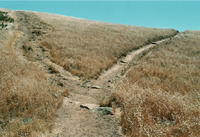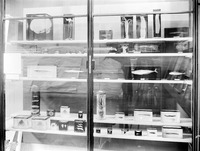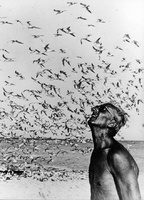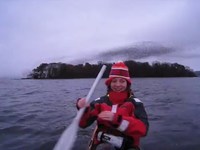Items
Site
The Medicine Chest
keywords is exactly
journey
-

Or
"The processes of digression and diversion have much in common with what the writer Ross Chambers (1999) calls ‘loiterature’. Chambers investigates the digressive, category-blurring genre of writing found in works such as Nicholson Baker’s 'The mezzanine', Paul Auster’s 'City of glass' and Laurence Sterne’s 'Tristam Shandy'. Loiterly writing, according to Chambers, disarms criticism by providing a moving target, shifting as its own divided attention constantly shifts. Criticism depends on the opportunity to discriminate and hierarchise, determining what is central and what is peripheral (Chambers 1999: 9), which this form eludes by resisting contextualisation or singular categorisation. Loiterature promotes sites of endless intersection, where attention is always divided between one thing and some other thing, always willing and able to be distracted, contrasting ‘the disciplined and the orderly, the hierarchical and the stable, the methodical and the systematic’ (Chambers 1999: 10). In contrast to methods of science that seek to stabilise objects within taxonomic systems or that require the formulation of hypotheses to provide direction for experimentation and a basis for concrete outcomes, the processes of curatorship and artmaking revel in rerouting and redirecting and in diversion and digression" (Liebenberg 2021: 286). -

#165317 Dipsy
In 2015, Conservation International scientists in Indonesia attached satellite transmitters to the dorsal fins of whale sharks to learn more about their migratory movements and diving behavior. Dipsy, a 4.57-meter male, spent much of his 17-month deployment in Triton Bay but also visited the Aru and Kei Islands – one of our first Kaimana whale sharks to explore the Arafura Sea – before returning to Kaimana. He hit a maximum depth of 625 meters. -

#165321 Yoda
In 2015, Conservation International scientists in Indonesia attached satellite transmitters to the dorsal fins of whale sharks to learn more about their migratory movements and diving behavior. Yoda had a lengthy 26-month deployment, spending all of that time in Cendrawasih Bay. The 4.83-meter male dove to a maximum depth of 1,375 meters, reaching the bottom of the bay at one of its deepest points. -

#151097 Fijubeca
In 2015, Conservation International scientists in Indonesia attached satellite transmitters to the dorsal fins of whale sharks to learn more about their migratory movements and diving behavior. At just 3 meters in length (about 10 feet), Fijubeca logged an impressive 9,000 kilometers (5,592 miles) during his deployment. He visited eight of the Bird’s Head Seascape's marine protected areas (MPAs), reaffirming the placement of MPAs as related to megafauna migratory routes. -

#168184 Sunbridge
In 2015, Conservation International scientists in Indonesia attached satellite transmitters to the dorsal fins of whale sharks to learn more about their migratory movements and diving behavior. Sunbridge was one of our first sharks tagged in Saleh Bay, Sumbawa, where he spent his entire 14-month deployment. Though this 6.23-meter male spent a fair bit of time on the surface, he frequently visited the bay's bottom at a maximum depth of 350 meters. -

#165905 Sebastian
In 2015, Conservation International scientists in Indonesia attached satellite transmitters to the dorsal fins of whale sharks to learn more about their migratory movements and diving behavior. Sebastian spent most of his 27-month deployment in Cendrawasih Bay but also recorded a visit to the Mapia atoll and ventured past Biak into PNG coastal waters. He eventually returned to Cendrawasih, where his tag's battery expired, having logged a maximum dive of 1,125 meters. -

Terra Nova
Robert Falcon Scott’s Terra Nova expedition reached the South Pole on 17 January 1912 — 23 days too late. Inside a small tent supported by a single bamboo flying a Norwegian flag, was a record of the five who had been the first to reach the pole: Roald Amundsen, the leader, and his team - Olav Olavson Bjaaland, Hilmer Hanssen, Sverre H. Hassel and Oscar Wisting. On 19 January, they began their 1,300 kilometre journey home, Scott writing: “I’m afraid the return journey is going to be dreadfully tiring and monotonous” (Scott 1914: 548). -

Walter Floyd arrives by boat
"The BWC shop was located a short walk from Walter Floyd’s dental practice which he bought in 1904 (for £2,404 16s 8d) and shared with his partner, William Johnston. It is uncertain when Floyd first came out to South Africa, but records prove that he was living here by January 1902 (Hart & Lydall, 1981: 1)" (Liebenberg 2021: 52). In interviews with Mary Floyd in 2015, I showed her this photo of her father-in-law on the boat, en route to Cape Town, and asked her whether she knew who the woman in the photo was. (She appeared in quite a few photos of Floyd's from this period – one especially intimate one showing her lying on a beach and smiling coyly at the photographer.) Was it Agnes, perhaps? She said it definitely wasn't. -

Pier 59
A monumental installation piece recreating the ocean liner Titanic as a floating deck plan (in its original size – 882 feet long; 92 feet wide), projected in light onto the surface of the Hudson River at Pier 59 (due west of West 18th Street), the ship's intended destination in 1912. -

Strange landscapes
In a short story by the writer Alice Munro titled, 'Walker Brothers Cowboy', a young girl joins her father, a fox farmer turned traveling salesman, on his visits to homes in the countryside where they live. After observing her father nearly getting doused with a chamber pot of urine by an unwelcoming customer, he veers off his usual rounds to visit a woman whom she slowly understands to be his sweetheart from when he was younger. Driving back home, she thinks about the events of the day: "So my father drives and my brother watches the road for rabbits and I feel my father's life flowing back from our car in the last of the afternoon, darkening and turning strange, like a landscape that has an enchantment on it, making it kindly, ordinary and familiar while you are looking at it, but changing it, once your back is turned, into something you will never know, with all kinds of weathers, and distances you cannot imagine. When we get closer to Tuppertown the sky becomes gently overcast, as always, nearly always, on summer evenings by the Lake" (Munro 2010: 23). -

Ma
The Japanese have a word, ‘ma’, for this interval which gives shape to the whole – this ‘gap’, ‘opening’, ‘space between’ or ‘time between’. Ma is not something that is created by compositional elements, rather it can be understood as the thing that takes place in the imagination of the human who experiences these elements. A room, for example, is called 'ma', as it refers to the space between the walls. Or a rest in music, which indicates a pause between the notes or sounds (Pilgrim 1986: 255). -

Where their lives took on true weight
In Alice Munro's short story 'Post and Beam', the two protagonists return home from a short vacation: "Up Capilano Road, into their own part of the city and their own corner of the world, where their lives took on true weight and their actions took on consequences. There were the uncompromising wooden walls of their house, showing through the trees" (Munro 2001: 212). -

The Sea Birds of Isabella
Aired between 1968 and 1976, 'The Undersea World of Jacques Cousteau' was a documentary television series about underwater marine life. It was directed by Alan Landsburg and hosted by French filmmaker, researcher, and marine explorer Jacques Cousteau. In the 33rd episode of the series, titled 'The Sea Birds of Isabella', the crew journeys off the coast of Mexico to an island to study its tropical birds. Three years after it was shown, Cousteau's son, Phillipe (then aged 38) died trying to land his seaplane, called the Flying Calypso, on the Taos River in Portugal. -

Murmeration
A short film that follows the journey of two girls in a canoe on the River Shannon and how they stumble across one of nature's greatest phenomenons; a murmuration of starlings.


